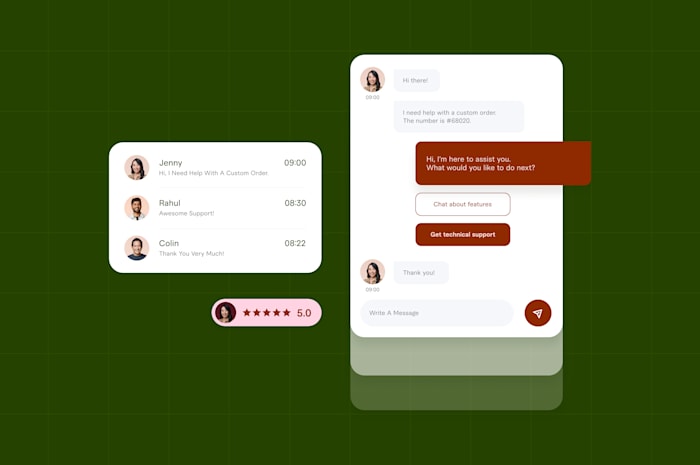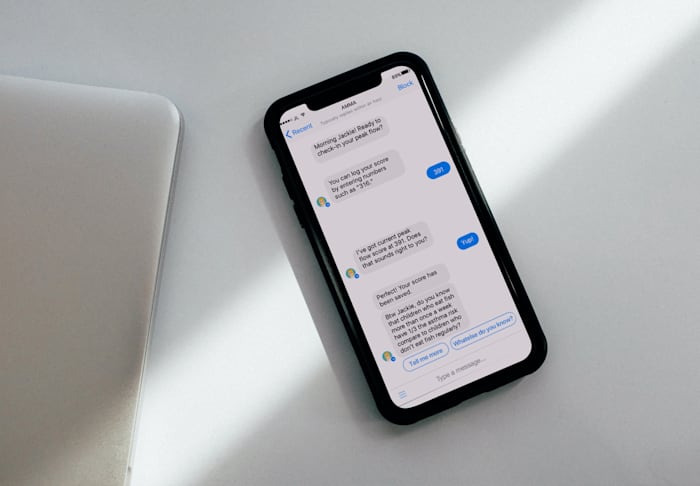5 Types of Chatbots To Grow and Scale Your Business
Leverage chatbots to automate mundane tasks and free up time for the work that matters. Learn how to pick the right one to meet your business goals.
 November 13, 2023
November 13, 2023 11 minute reading
11 minute reading
Chatbots are becoming an increasingly popular tool for businesses of all sizes—a staggering 88% of online shoppers report interacting with a chatbot in 2022. From small businesses to large corporations, chatbots offer a cost-effective way to improve customer service and automate mundane tasks. However, as technology evolves, so have the different types of chatbots, which is why we’ve compiled the top five options for small and medium-sized businesses (SMBs) and how to pick the right one.
What are chatbots?
Chatbots are computer programs designed to process and stimulate conversation with human users through voice or text conversations. They use artificial intelligence technologies such as natural language processing (NLP) and machine learning (ML) to understand user input and respond accordingly. Chatbots are used for a variety of SMB use cases—from support chatbots to marketing automation chatbots.
Chatbots work by providing customers with a convenient source of support 24/7, without the need for human interaction. Sixty-two percent of consumers would rather interact with a chatbot than wait 15 minutes to speak with a human agent. There are various tools and platforms available for implementing chatbots, including messaging apps such as WhatsApp and Facebook Messenger. Discord is another common platform for chatbots to help with community management, as are social media platforms like LinkedIn, Instagram, and X (formerly Twitter). Each platform offers its own set of features and capabilities that must be considered when choosing the right solution for your business needs.
Find an AI expert on Fiverr
5 types of chatbots for SMBs, and how to pick the right one
There are various types of chatbots available for SMBs to use to improve customer experience and scale. While some organizations may choose to implement a simple chatbot—like a rule-based or button-based one—others may opt for a more complex, AI-powered solution.
1. Rule-based chatbots
Rule-based bots are the simplest form of chatbot technology and work by following a predefined set of rules and conditions. Rule-based bots respond to user input with each subsequent answer branching into another new scenario. Business owners program these chatbots to respond accordingly to a variety of common user queries. Certain conditions—such as keywords or sequence of words—determine how rule-based bots will respond.
Use cases for rule-based chatbots
Rule-based chatbots are a helpful addition to almost any SMB in any industry. Their use cases are general, and these simple chatbots are easier to implement than more complex AI bots.

They’re also called keyword-recognition-based chatbots, because they provide a response based on the keywords the consumer has entered. Rule-based chatbots can be used for:
Customer support. This chatbot technology is the most common type for solving repetitive customer queries. They’re more robust and helpful than FAQs, but they’re designed to take the place of a 24/7 support team and be available around the clock to answer a user’s questions.
Scheduling. Program your rule-based chatbot to take care of the tedious work for you while simultaneously improving your leads. Integrate chatbot software to handle setting up calls with new clients or scheduling appointments.
Information. Jot down the most frequently asked questions you receive about your products. Program a rule-based bot to automatically generate the answers to questions such as, “How much does Plan X cost?” or “How many plans exist?”
2. AI chatbots
AI-powered chatbots are more complex than simple chatbots and leverage NLP technologies like ML or deep learning (DL). These advanced AI techniques allow these bots to understand context in real-time, learn from user conversations, and provide more accurate responses based on algorithms.

If a customer talks to the chatbot once, the conversational AI bot will remember their interaction. Next time they interact, the chatbot can pull information from the previous conversation to better replicate a human conversation and resolve queries quicker and more accurately.
Use cases for AI chatbots
AI-powered bots are best suited for complex customer queries. Those in the ecommerce, health care, and finance industries are more likely to adopt AI bots, due to the variety of questions and conversations happening. If you have a complex website, many products, or are receiving more customer inquiries than you can handle, an AI chatbot is right for you. AI-powered chatbots can be used for:
Marketing. AI bots are great at providing personalized recommendations based on what they know about each individual user they interact with. These contextual chatbots are fantastic for customer engagement, as buyers will leave the interaction with unique suggestions they couldn’t get from a quick Google search.
First contact. Some inquiries require a human agent to answer questions. AI chatbots can act as the first contact to determine whether AI can resolve the issue or if human agents—and from what department—need to enter the conversation.
Customer support. You can’t anticipate every common question or its specific wording, especially if you have many products and lots of customers. AI chatbots can be an upgrade to a rule-based bot for customer support, since they have a larger knowledge base that is adapting and growing over time.
“We offer the ability to chat with our bot or directly with one of our team members, and we found the offering was less frustrating than the kind where you find it very hard to actually get through to a real person,” says Gary Warner, marketing manager at Joloda Hydraroll, the global partner for loading and unloading systems. “We have found that having the bot working as a trigger to get potential customers to agree to a callback is a friendly, easy way for our sales team to get their foot in the door.”
3. Menu-based chatbots
Menu or button-based chatbots provide users with an interactive interface that includes menu buttons of options instead of a text input field. This type of bot is great when there are multiple, easy-to-follow and predict steps in the conversation process.

Menu-based chatbots present customers with a list of options—in the form of a decision tree—that they can select from rather than typing out custom questions.
Use cases for menu-based chatbots
While menu-based chatbots are among the most popular types of chatbot software, they come with their limitations. These bots typically take the longest for the customer to reach their desired solution, since they need to navigate through a field of options and can’t input custom text. However, they’re popular for a reason, and have plenty of use cases SMBs can enjoy. Menu-based chatbots can be used for:
Ordering. Many retailers and restaurants rely on menu-based chatbots to assist customers with placing an order. These chatbots can redirect them to the correct page or complete the task at hand after gathering the necessary information.
Ecommerce. Lots of online boutiques have menu-based chatbots to make it easy for shoppers to browse products, track their orders, or manage returns. Again, a more complex chatbot can accelerate the process, but they’re still a good option for startups.
Customer support. This use case is applicable for all types of chatbots, but it’s a great option for menu-based bots, as users can easily navigate to the correct department they need help from.
4. Voice chatbots
Talking is often more natural than typing, which is why many SMBs opt for voice chatbots. They offer a convenient and comfortable option for shoppers and rely on AI to respond and convert text to voice.
Seventy-one percent of consumers prefer to place a query via voice rather than typing, and 22% of consumers have made purchases through voice. Apple’s Siri, Amazon’s Alexa, and Google Assistant have dominated the virtual assistant marketplace and serve as great examples to follow when building a voice chatbot for your own business.
Use cases for voice chatbots
Since voice chatbots don’t require typing or clicking through a menu, they’re a fast, convenient alternative to other chatbots—especially when they’re powered by AI. Though shoppers may get frustrated if their speech isn’t understood correctly, the advancement of AI and speech-to-text technology is improving these bots constantly. Voice chatbots can be used for:
Education. Consumers might be more likely to ask questions and learn about your products if it’s as simple as verbally asking a question. Voice chatbots often are programmed to be informational and educational.
Human resources. Don’t restrict chatbots to customer-facing—they’re great for making internal processes more efficient as well. SMBs can use voice bots to assist with onboarding and act as a knowledge base for new employees.
Ecommerce. Customers that prefer shopping online tend to be more tech-savvy, and voice chatbots enable them to self-serve their own queries. Convenience is always appreciated, and offering a voice chatbot as part of your ecommerce business is a sure way to improve customer satisfaction.
5. Hybrid chatbots
Hybrid chatbots combine both rule-based and AI-powered components into one solution that handles both simple requests and more complex interactions between users and SMBs. Hybrid solutions often use an AI engine, but also include menu options or buttons so users can easily navigate through different topics without having to type out detailed instructions each time.
Use cases for hybrid chatbots
Hybrid chatbots begin with a fully automated presence, but allow for live agents to jump in if the technology isn’t able to quickly resolve customers’ queries. Hybrid chatbots can be used for:
Customer support. Hybrid chatbots use AI to stimulate natural conversations and make it easy for a human agent to intervene. Thanks to this, they’re a great choice for businesses wanting to automate customer service-related tasks and improve the overall customer experience.
Lead generation. Since AI powers hybrid chatbots, they’re the perfect solution for interacting with new leads. Chatbots can capture customers’ contact information and provide helpful information on products they’re browsing.
Sales. While sales might seem like an area better suited for humans, the power of AI has equipped chatbots with all the capabilities needed for selling and personalizing. Free up your human agents and empower a hybrid chatbot to start driving more revenue for you.
Tips for choosing the right type of chatbot for your business
When selecting a chatbot solution for your business needs, it’s important to consider the complexity of customer interactions you’ll be dealing with, as well as the resources available for development and maintenance, before making a decision. Chatbots shouldn’t eliminate the need for human resources. It’s important to have human agents available in high-risk situations where automated responses may not be suitable.
By choosing the appropriate chatbot solution that works toward business goals—while taking into account resources for development and maintenance—SMBs can reap the rewards associated with improved user experiences, including increased revenue growth.
“We’ve seen 35% faster response times since launching our chatbot and 20% higher customer satisfaction ratings as a result,” says Priyanka Swamy, CEO and founder of Perfect Locks Hair Company. “We’ve also seen a 15% increase in sales conversion rates, since the chatbot helps customers navigate product selections and provides personalized recommendations.”
Follow these tips to figure out the right type of chatbot for your SMB:
Evaluate current business processes for chatbot integration. Figure out where your business would most benefit from a chatbot, and where it would be easiest to add one into your current processes.
Customize chatbot responses to align with specific customer needs. Program your chatbot according to the type you have selected. Before making it available to customers, try conversing with it and see where it excels and where it falls short.
Integrate chatbot capabilities across communication channels. Determine which platforms are best suited for your chatbot and work with expert freelancers to launch your chatbot.
Monitor chatbot metrics and user interactions. Always look at the data and conversation logs between your chatbot and customers. This allows you to spot areas for improvement and measure the chatbot’s effectiveness at resolving customer queries.
Implement regular updates and enhancements. Optimize your chatbot’s effectiveness by continuously updating it and adding any necessary new scripts. Work with prompt engineers or other AI specialists to make your chatbot better.
Engage with customers to gather feedback. Don’t just guess where your chatbot could improve—ask real customers. Based on their feedback, refine your chatbot to better meet their needs.
Stay updated on emerging chatbot trends and technologies. The world of AI is constantly evolving—from adding plug-ins to ChatGPT to using prompt writers. Keep up-to-date on new trends or consult with AI experts to take your business to the next level.
Top services for chatbot development
When it comes to developing a chatbot, businesses have many options. Hiring an in-house development team can be costly and time-consuming for SMBs, while using traditional software development services can be expensive and limited in scope. Fortunately, businesses today have access to freelancer platforms such as Fiverr, which provide an affordable and efficient alternative for chatbot development.
Join Fiverr to access a growing marketplace of experienced freelancers who can automate your online presence with chatbot development services. Consider other AI technologies, such as training ChatGPT on your business data to automate other processes. Whether you’re looking to implement a rule-based bot, AI-powered bot, or need help deciding which is best for your SMB, Fiverr experts can help.




